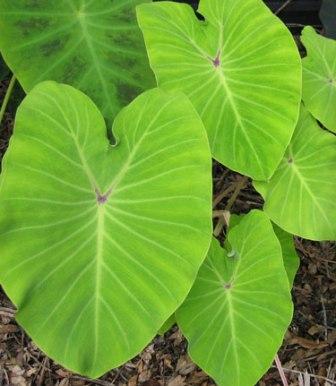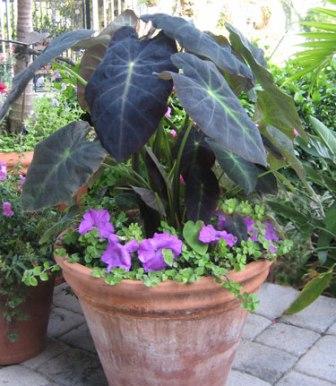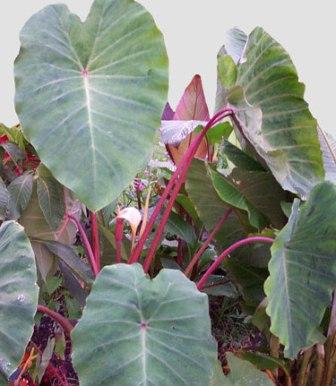As I have addressed in previous posts, much of the attention my corporate design work (e.g. Gardens at the Bank of Springfield) receives can be attributed to my use of tropicals in the mixed border. It is unexpected to see lush tropical foliage flourishing in central Illinois. This season I have installed a truly subtropical garden complete with several species of palm, banana, croton, ginger, canna, fern and the like.
In seasons past I have had great success growing elephant ear (Colocasia). Not surprisingly, they are an important part of this year’s display. Named for the leaves, which are shaped like a large ear or shield, June’s GGW Plant Pick of The Month instantly adds an exotic touch to any container or garden.

Colocasia esculenta 'Elena'- 4-6' sun tolerant, chartreuse yellow leaves with purple veination, try pairing with Tradescantia pallida (Image courtesy of Agristarts, Inc.)
Colocasia is a genus of six to eight species of flowering plants native to tropical Polynesia and southeastern Asia. There are several popular ornamental cultivars of Colocasia esculenta, however it is important to note that C. esculenta and other members of the genus are primarily cultivated for their edible tubers, a staple food for over 100 million people worldwide.

Colocasia esculenta 'Black Beauty'- a mutation of the cultivar 'Illustris' with 3-4' nearly black leaves, try pairing with Solenostemon 'Sedona' or Helichrysum petiolare (Image courtesy of Agristarts, Inc.)
Colocasia is best grown in fertile, humusy, organically rich, medium to wet soils in full sun to part shade. Plants will do well with roots submerged in a pond or water garden. Elephant ear’s produce a great deal of growth in one season and appreciate regular fertilization. Tubers may be left in the ground year round in USDA zones 8-10. In zone 5, I treat them as an annual and have not tried to overwinter the tubers. Have you had success overwintering Colocasia?

Colocasia esculenta 'Pink China'- 4-6' cultivar with excellent cold tolerance, hardy to USDA zone 6 (Image courtesy of Agristarts, Inc.)
Colocasia looks great in mass or as a specimen/centerpiece. Try planting elephant ears with Alocasia, Caladium or Xanthosoma as they have similar leaf shapes. Colocasias work well with other exotic foliage plants such as- palms, Manihot, Musa, croton, ginger, canna, Cyperus papyrus, Ricinus, and Solenostemon to name a few. Do you have any favorite planting combination including Colocasia?
Plant Delights Nursery, Inc. has a great selection of many hard-to-find elephant ear selections. Do you know of any other good sources? Please post a comment.
If this is your first time visiting GGW Plant Pick of The Month and you’d like to participate, simply post your comments below and a link to your own site where you’ve posted photos of elephant ear cultivars and comments about your experiences working with the plant, successful planting combinations, etc.
